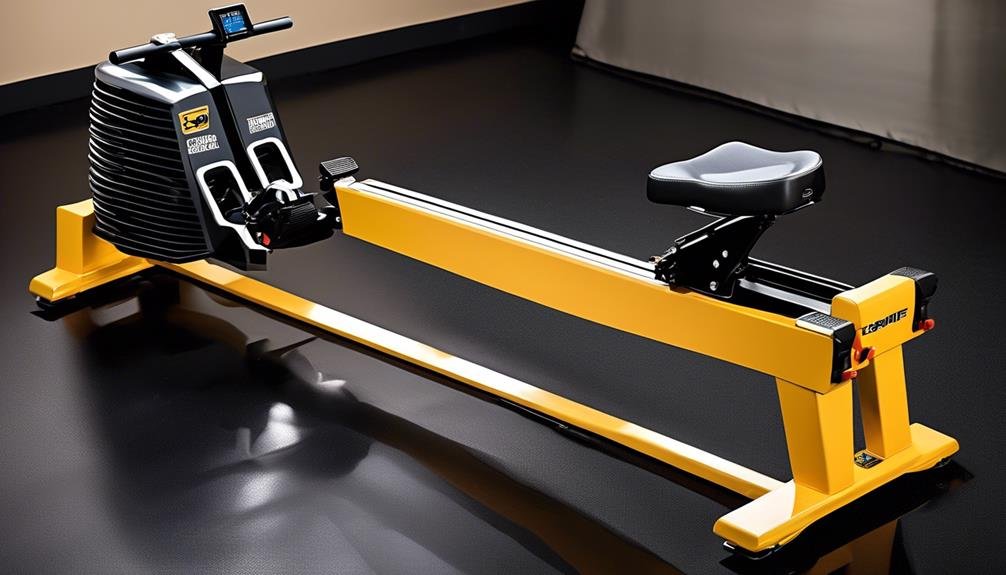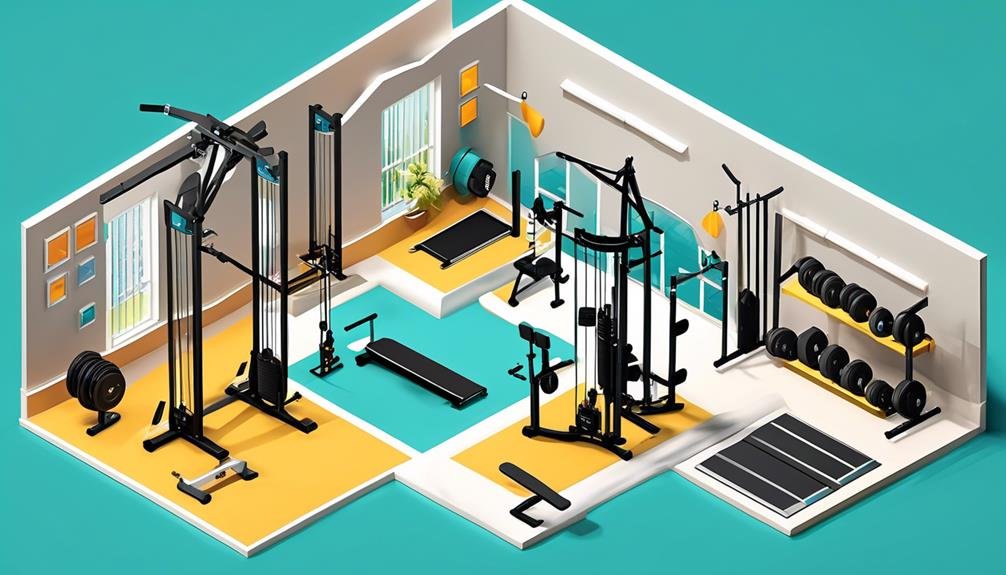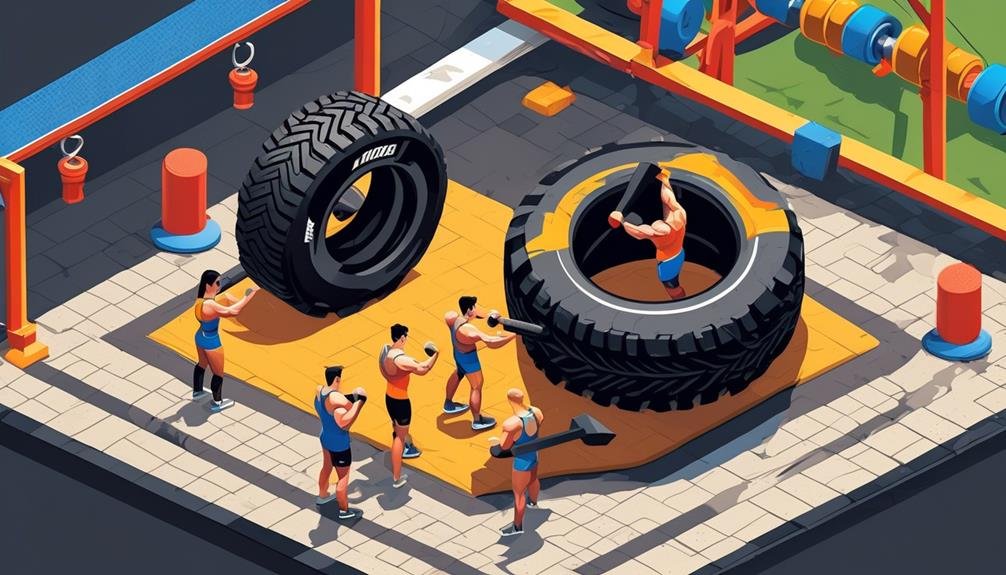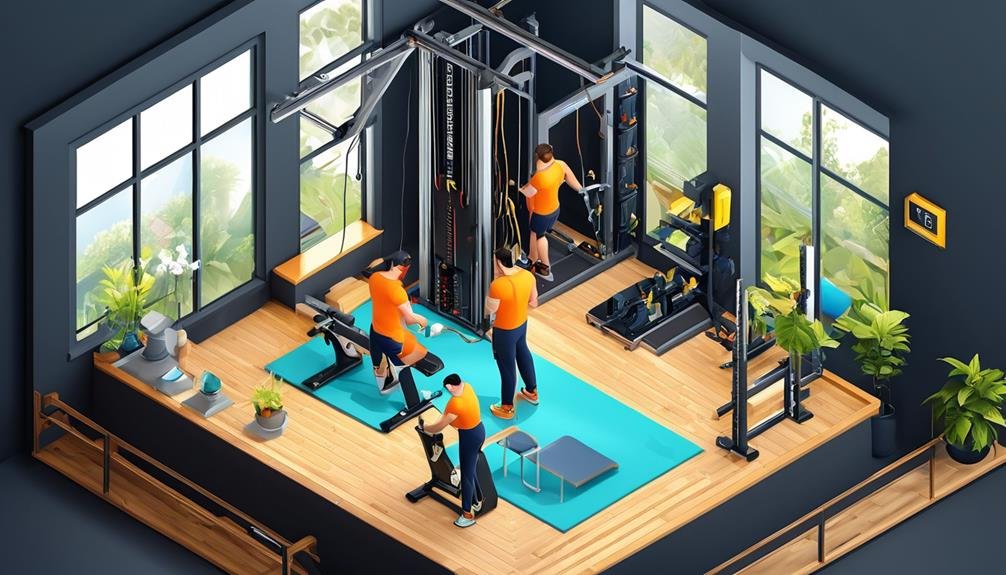Disclaimer: This content is for informational purposes only and does not replace professional medical advice, diagnosis, or treatment. Always consult a qualified healthcare provider before beginning any new exercise program.
You might be wondering if owning a home rowing machine is worth the maintenance it requires. The truth is, while regular maintenance is necessary, it's not as daunting as it may seem.
By dedicating a few minutes of your time each day and following a simple monthly maintenance routine, you can ensure that your rowing machine stays in top-notch condition, providing you with an effective workout for years to come.
So, let's explore the various aspects of maintenance and discover just how much effort it truly entails.
Key Takeaways
- Regular cleaning and inspection of the slide rail, including wiping it down with a clean, damp cloth, is necessary to prevent sweat and dirt buildup.
- It is important to regularly inspect the rowing machine for wear or damage, such as loose bolts or cracks, and promptly address any issues to prevent further damage.
- Regularly tightening loose screws or bolts is necessary to maintain machine stability, as vibrations and movements during rowing can cause hardware to become loose.
- Proper lubrication of moving parts, such as the chain, is essential for smooth operation and prolonged chain life. Using the recommended oil and regularly checking for stiffness or damage in the chain is important for maintenance.
Cleaning the Slide Rail
To maintain optimal performance, regularly wipe down the slide rail of your home rowing machine to prevent sweat and dirt buildup. The slide rail is a crucial component of your rowing machine that allows for smooth and fluid movements during your workout. By keeping it clean, you ensure that it functions properly and lasts longer.
To clean the slide rail, use a clean and damp cloth. Avoid using abrasive cleaners or solvents as they can damage the surface. Simply wipe the rail down, paying extra attention to areas where sweat and dirt tend to accumulate. This will help prevent any buildup that could affect the performance of your machine.
In addition to cleaning the slide rail, it's also important to inspect it regularly. Look for any signs of wear or damage, such as loose bolts or cracks. If you notice any issues, address them promptly to prevent further damage.
Inspecting Pedal Straps
Regularly checking the condition of your rowing machine's pedal straps is crucial for maintaining safety and optimal performance. The pedals and pedal straps are essential components of your home rowing machine that require regular maintenance. Before each workout session, take a moment to inspect the pedal straps for any signs of fraying or damage. Ensure that the straps are securely attached to the pedals to prevent any accidents or injuries during your workouts.
If you notice any wear or damage on the pedal straps, it's important to promptly replace them. Worn or damaged pedal straps can compromise your safety and may affect the performance of your rowing machine.
Additionally, inspect the pedal attachment points for any signs of wear or stress. If you notice any issues with the attachment points, it's recommended to contact the manufacturer or a professional for assistance.
Checking Belt Drive Stitching
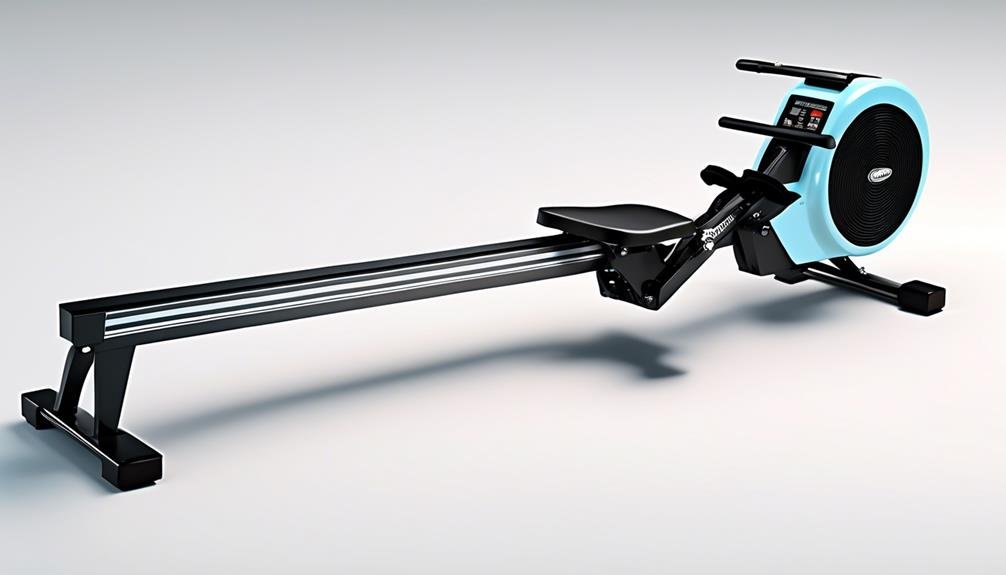
As you continue to maintain your rowing machine, a crucial aspect to address after inspecting the pedal straps is checking the stitching on the belt drive. Regularly monitoring the belt drive stitching is essential to ensure the smooth and safe functioning of your rowing machine.
Take the time to inspect the stitching for any signs of wear, damage, or unraveling. Damaged stitching can hinder your rowing experience and may even require replacement of the belt drive. By detecting stitching issues early on, you can promptly address them and avoid unnecessary wear and tear on other parts of the machine.
Make sure that the stitching is securely in place to maintain optimal performance and prevent any accidents during your workouts. Proper maintenance of the belt drive stitching contributes to the overall longevity of your rowing machine and ensures that you can enjoy effective and efficient rowing sessions for years to come.
Take the time to regularly check and maintain the stitching to get the most out of your rowing machine and avoid any avoidable wear and tear on the pedals and other components.
Assessing Handlebar Condition
Assess the condition of your handlebar to ensure optimal functionality and safety during your rowing workouts. Here are three key points to consider when assessing the handlebar condition:
- Regularly check the handlebar for any signs of wear, such as fraying or cracking. These issues can compromise the structural integrity of the handlebar and may lead to accidents or injuries during your workouts.
- Make sure the handlebar is securely attached to the machine and doesn't wobble during use. A loose or unstable handlebar can affect your rowing technique and potentially cause discomfort or strain on your arms and upper body.
- Look for any rough or sharp edges on the handlebar that could cause discomfort or injury. Smooth, well-maintained handlebars ensure a comfortable grip and minimize the risk of blisters or abrasions during your rowing sessions.
Tightening Hardware as Needed
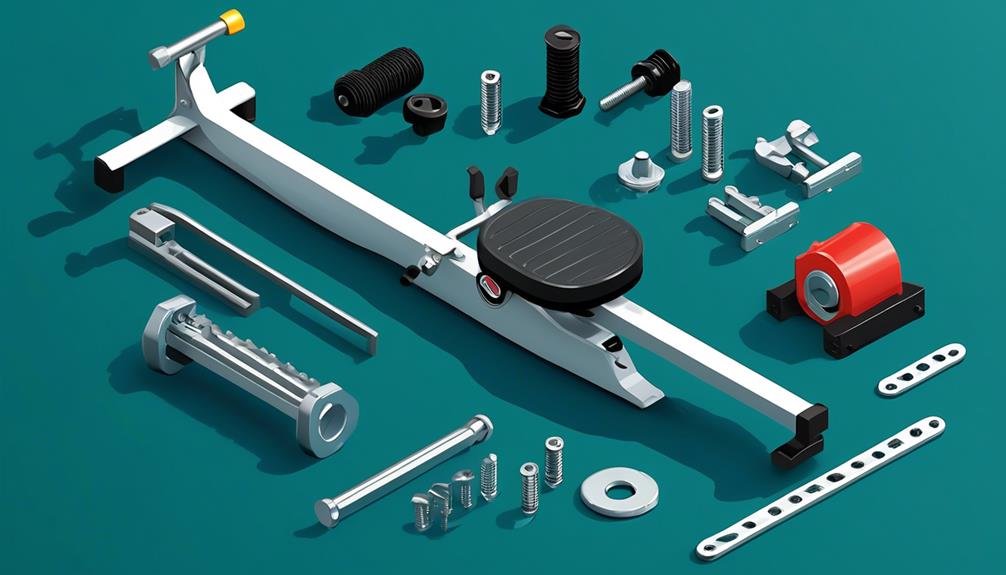
To maintain optimal functionality and safety of your home rowing machine, it is important to regularly tighten any loose screws or bolts. Over time, the vibrations and movements generated during rowing can cause hardware to become loose, which may compromise the stability and performance of the machine. By tightening the hardware in a timely manner, you can prevent further loosening and ensure that all machine parts are securely fastened.
To help you keep track of the hardware that needs tightening, here is a table outlining the key areas to check:
| Machine Part | Hardware to Tighten |
|---|---|
| Frame | Bolts securing the frame together |
| Footrests | Screws attaching the footrests to the frame |
| Seat Track | Bolts securing the seat track to the frame |
Regularly inspect these areas and use the appropriate tools, such as a wrench or screwdriver, to tighten any loose hardware. It is important to note that over-tightening can also cause damage, so be sure to follow the manufacturer's guidelines and tighten the hardware to the recommended torque.
Lubricating Moving Parts
To ensure optimal performance and longevity of your home rowing machine, it's essential to properly lubricate the moving parts. Here are three key points to keep in mind when lubricating your rowing machine:
- Lubricate the chain: Regularly lubricating the chain is crucial for smooth operation and prolonged chain life. You can use purified mineral oil, 3-IN-ONE oil, or 20W motor oil for this task. Apply the oil along the entire length of the chain using a paper towel, and wipe off any excess oil. Avoid using cleaners or solvents like WD-40 to clean the chain, as they can compromise its performance.
- Inspect for stiffness and wear: It's important to inspect the chain for stiff links and replace it if lubrication doesn't resolve the issue. Additionally, check the chain-handle connection for wear and tighten the shock cord if the handle doesn't fully return. For institutional users, these inspections should be done monthly, while for regular users, they should be done every 250 hours of use.
- Use genuine parts: To ensure safety and optimal performance, always use genuine parts from the manufacturer. If you notice any worn or weakened parts, replace them immediately to prevent injury or poor machine performance.
Monitoring Electronic Components
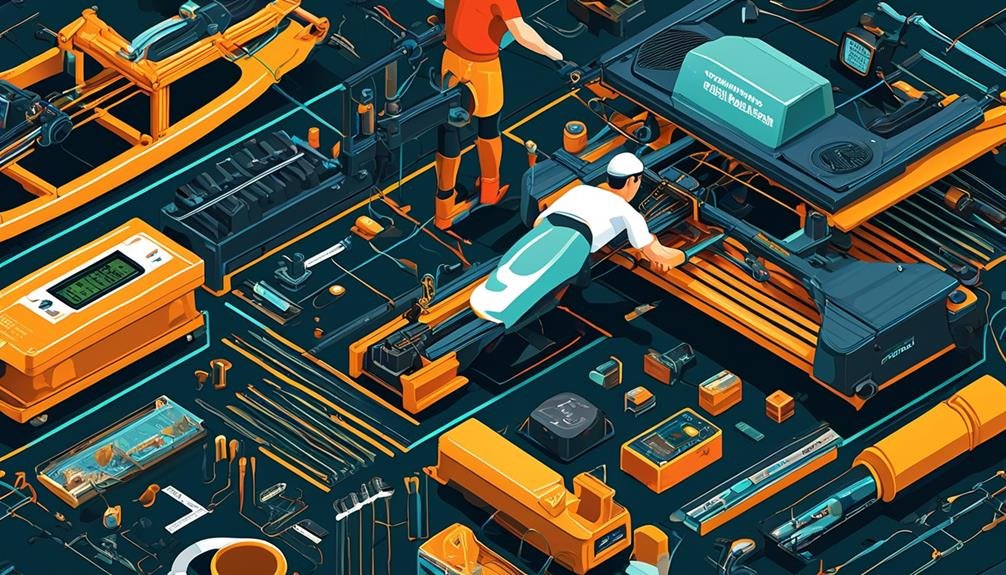
To ensure the continued optimal performance and longevity of your home rowing machine, it's important to monitor the electronic components for any signs of malfunction or deterioration.
The electronic components play a crucial role in the overall functioning of the machine, including the Performance Monitor and digital display. Regularly checking for loose wires, connectors, or solder joints can prevent malfunctions and potential electrical hazards.
It's also essential to monitor the condition of circuit boards for any signs of corrosion, damage, or overheating, as these issues can affect the machine's performance. Keep an eye on the digital display for any flickering, dimming, or erratic behavior, as these may indicate a need for repair.
Additionally, check the power supply and cables for fraying, wear, or loose connections to ensure consistent and safe operation. Monitoring the electronic components for any unusual smells, excessive heat, or abnormal noise is crucial, as these may be signs of a potential issue.
Regular Maintenance Schedule
Perform a daily wipe down of the machine, paying extra attention to the slide rail to prevent dirt and sweat buildup. Regular maintenance is essential to keep your home rowing machine in optimal condition and ensure its longevity.
Here is a regular maintenance schedule to follow:
- Inspect and replace frayed or damaged pedal straps regularly. Check the stitching on the belt drive for any signs of unraveling or damage.
- Tighten hardware periodically to prevent loosening, especially after prolonged use or vibration. If any parts need replacement, contact support for the necessary replacements.
- Lubricate the chain every 50 hours of use with the recommended oil. Additionally, inspect the chain for any stiff links every 250 hours of use.
In addition to these specific tasks, conduct monthly maintenance to keep your rowing machine in top shape. Apply recommended oil to the moving parts, check for any signs of wear and tear, and inspect the water tank if you have a water-resistant rower. Paying attention to small details like pedals and the shock cord will help prevent avoidable wear and ensure a smooth and efficient rowing experience.
Frequently Asked Questions
How Do You Maintain a Rowing Machine?
To maintain a rowing machine, you should regularly clean the seat, handle, and footrests with a mild soap and water. Lubricate the chain and check the tension. Inspect for any loose or damaged parts and tighten or replace as needed.
Is a Rowing Machine Worth It at Home?
A rowing machine is definitely worth it for home use. It provides a full-body workout, improves cardiovascular health, and is low-impact. Plus, you can easily adjust the resistance to suit your fitness level.
How Often Should I Oil My ERG Chain?
You should oil your erg chain every 50 hours of use. Use purified mineral oil, 3-IN-ONE oil, or 20W motor oil. Apply oil to a paper towel and rub along the chain, wiping off excess. Avoid using WD-40 or solvents.
How Long Should You Use a Rowing Machine per Day?
To ensure optimal performance and longevity of your home rowing machine, it is essential to perform regular maintenance. This includes cleaning, lubricating, and inspecting the machine for any wear and tear. By doing so, you can maximize its lifespan and enjoy safe and effective workouts for years to come.
Conclusion
In conclusion, regular maintenance is essential for keeping your home rowing machine in optimal condition. By following the manufacturer's guidelines and performing daily cleaning, monthly inspections, and tightening of hardware, you can ensure the longevity of your machine.
Remember to lubricate moving parts and monitor electronic components regularly. By taking these steps, you can maximize the lifespan of your rowing machine and keep it functioning smoothly for years to come.
